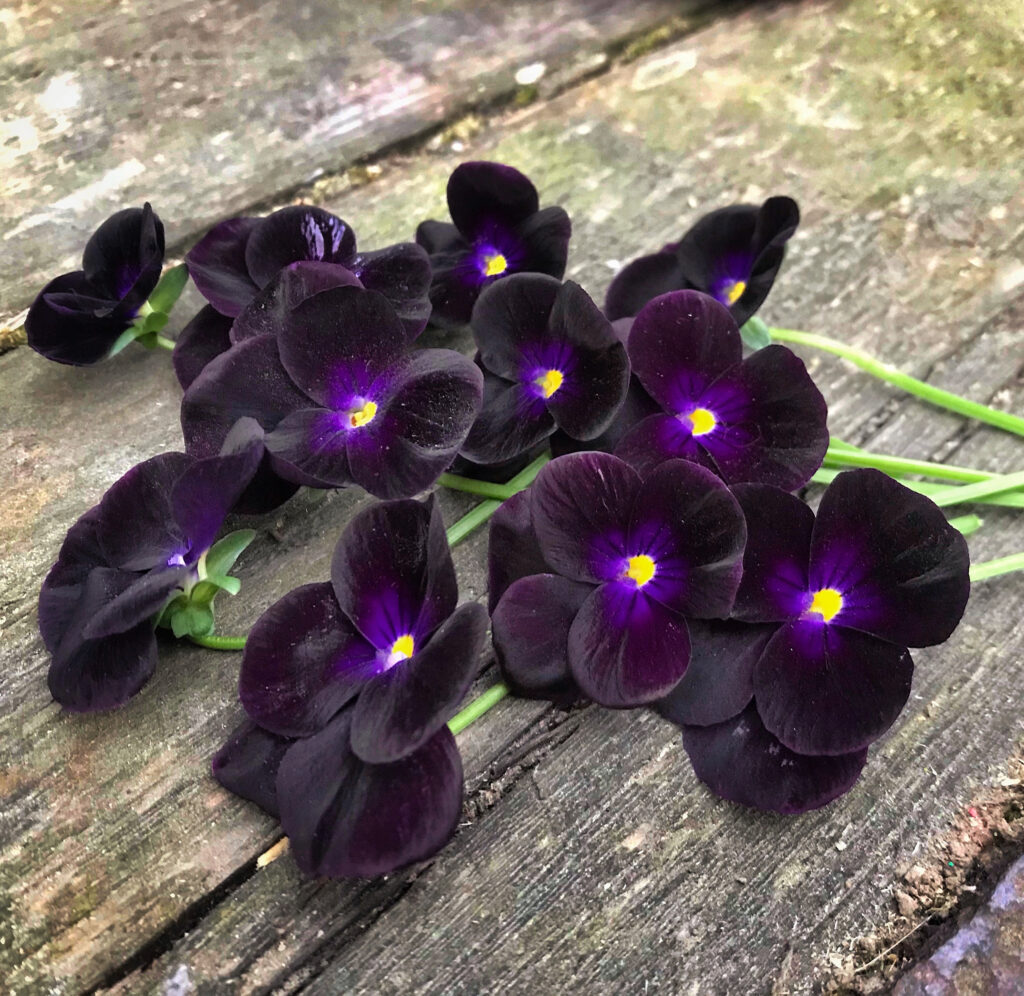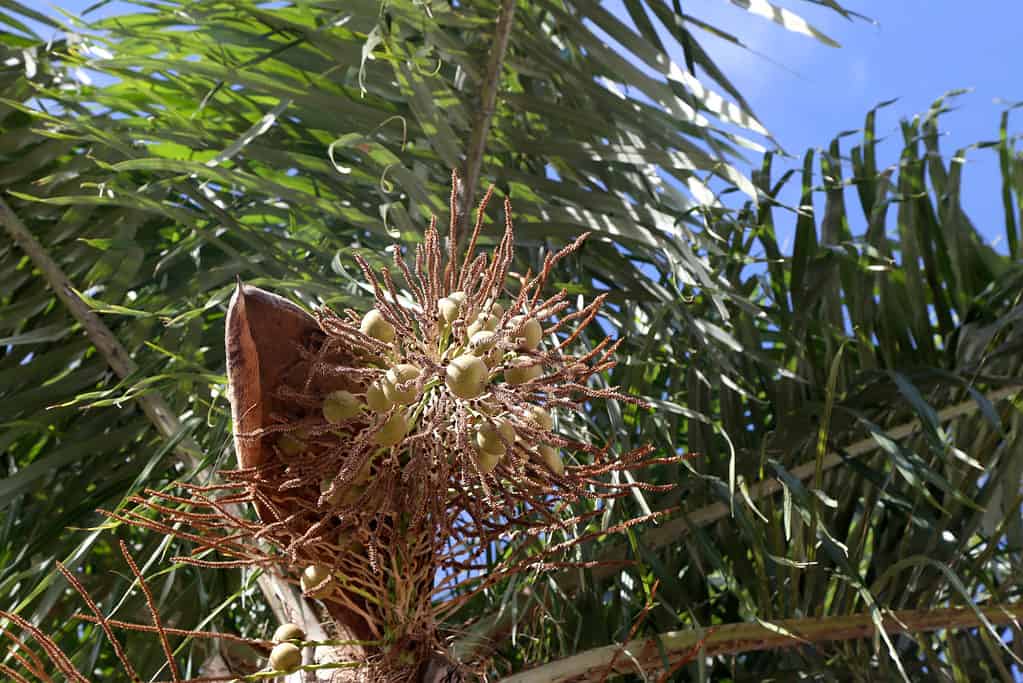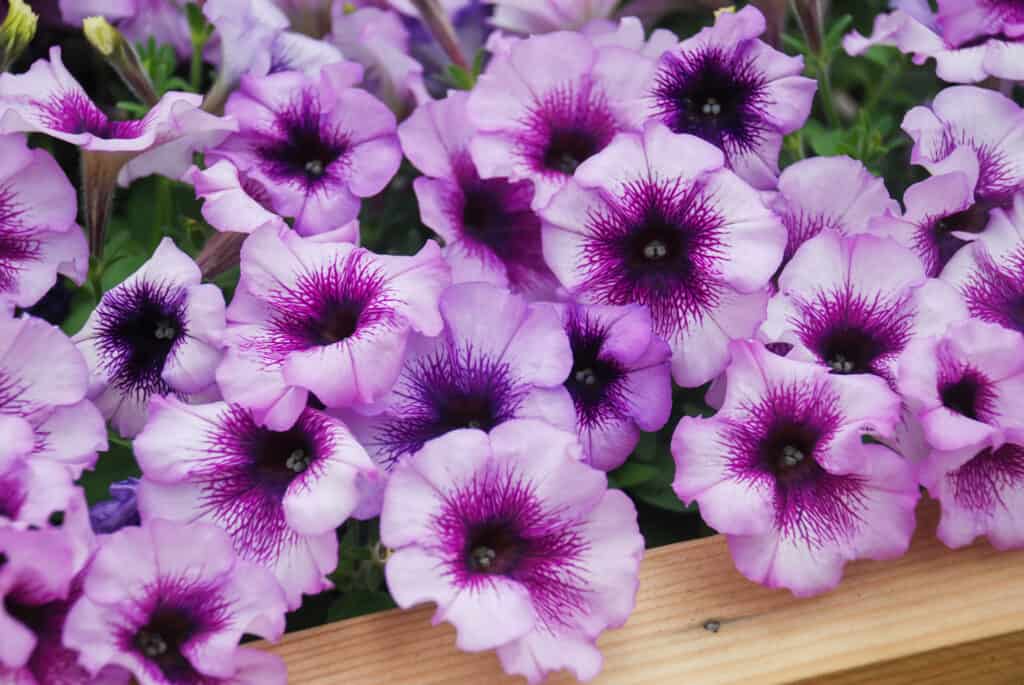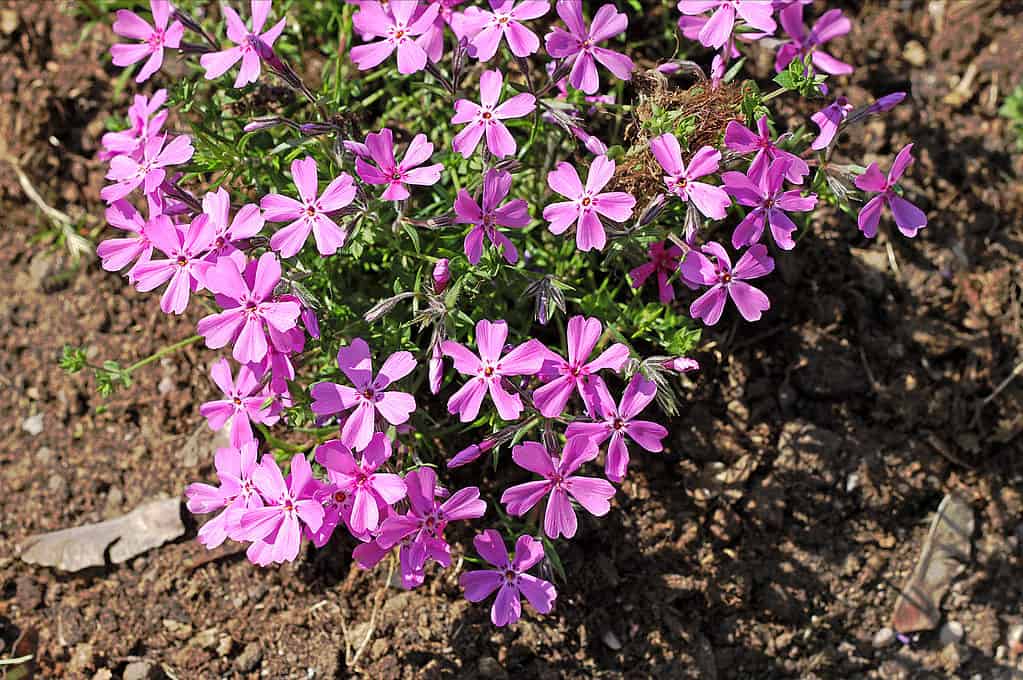Pause for a moment and picture a peaceful garden. What do you see? Perhaps it’s the majestic petals of a peony, gently swaying in the breeze. Or maybe it’s the prickly spines of a proud prickly pear cactus, standing strong in the desert’s heat. Each of these plants that start with P has its own story to tell. Each of them has its unique use as well, whether it is food, ornamental uses, landscaping, lumber, etc.
In this article, we’ll delve into a diverse array of plants that start with P. From the lush, tropical paradise of the palm tree to the peculiar and otherworldly pitcher plant, we’ll explore their fascinating characteristics and the roles they play in the natural world.
1. Potato

Potatoes thrive in hardiness zones 3 through 10b.
The first entry on our list of plants that start with P is the delicious potato. Potatoes, a staple in numerous global cuisines, bear a rich tapestry of history and utility that intricately binds societies and meals alike. Originating in the high plateaus of the Andes Mountains, they have journeyed across continents and through time to become the renowned tuber we universally savor today.
Not merely restricted to one archetype, potatoes blossom into a myriad of varieties, each carrying its unique palette of flavors and textures. The Russet, with its brown, somewhat rough exterior and fluffy interior, often finds its destiny in classic mashed potatoes or crispy french fries. Contrarily, the waxy Red Bliss cultivar is a marvelous selection for boiling or tossing into a vivacious summer salad due to its ability to hold shape well when cooked.
As we peel back the layers of potato utilization, it’s pivotal to appreciate their versatility which extends far beyond the culinary realm. Vodka, a spirit savored by many, often sources its foundational starch from potatoes, fermented to create a smooth, distilled beverage. Furthermore, potato starch is utilized in various industries, from textile manufacturing to paper production, wherein it acts as an adhesive or thickener. Meanwhile, back in kitchens, they metamorphose into an array of dishes from hearty stews in chilly winters to delicate gnocchi in vibrant Italian dishes.
While they may be humble in appearance, potatoes unite cultures and dishes, making them far more than a mere component of our meals. Their adaptive nature has spawned countless applications, from feeding nations to facilitating industries, cementing their status as an indispensable treasure within our global society.
2. Peony

Peonies tend to flower the most in hardiness zones 3 through 8.
©alex172/Shutterstock.com
Our first flower in our list of plants that start with P is the stunning and colorful peony. Peonies, with their lush, full blooms and sweet, subtle scent, cascade through gardens, dousing them in a spectral display of colors that range from the palest pinks to the deepest maroons. Originally from Asia, peonies have blossomed into a beloved favorite among horticulturists and casual gardeners alike, dispersing their delicate charm through diverse climates and landscapes.
Various varieties enchant with their specific charms, such as the “Sarah Bernhardt,” a sumptuous double peony with soft, pale pink petals, and the “Coral Charm,” which dazzles with its unique, vibrant coral hue and semi-double form.
Not solely confined to ornamental displays, peonies unfurl their petals in various spheres of human interest. In traditional medicine, particularly within its Asian origins, peonies have been harnessed for their purported health benefits for centuries. The roots, especially, find themselves steeped into tonics believed to soothe various ailments, infusing medical practices with their botanical essence.
Furthermore, these flowering plants are not mere bystanders in cultural and social events. With their luxuriant petals and opulent aromas, peonies frequently grace weddings and celebrations as elegant floral arrangements, becoming silent yet striking participants in countless cherished memories.
3. Pansy

Though short-lived, pansies can grow well in hardiness zones 6 through 10.
©OlgaKuznetsova7/Shutterstock.com
Pansies are delightful and versatile flowering plants that have captured the hearts of gardeners and flower enthusiasts worldwide. These vibrant and hardy annuals or perennials are celebrated for their charming appearance and a wide range of colors and varieties, making them a popular choice for both ornamental and culinary purposes.
Pansies are available in various cultivars, each with its unique characteristics. The ‘Delta’ series boasts large, bold blooms, while the ‘Majestic Giant’ varieties are admired for their exceptionally large flowers. For those seeking a more whimsical touch, ‘Fizzy Lemonberry’ pansies feature cheerful bicolor petals reminiscent of sherbet.
In gardens, pansies are cherished for their ability to provide early spring and fall color. Their low-growing, bushy habit makes them perfect for borders, edging, or container gardening. Pansies thrive in cool temperatures and can endure frost, making them a go-to choice for adding a pop of color to late-season landscapes.
Beyond their ornamental value, pansies also find their way into culinary arts. These edible flowers, with a mild, slightly grassy flavor, are often used to garnish salads, desserts, and cocktails. They can be candied, crystallized, or used to infuse teas, imparting a delicate floral essence to culinary creations.
Moreover, pansies are not just a feast for the eyes and palate; they have historical significance as well. In the language of flowers, pansies symbolize thoughtfulness and remembrance, making them a popular choice for bouquets and arrangements that convey heartfelt sentiments.
4. Palm

Though different palms have different needs, Coconut Palms (pictured) thrive in zones 10, 11, and 12.
©PATRICIA PECEGUINI VIANA/Shutterstock.com
One of the most well-known fruiting trees on our list of plants that start with P is the palm. Palm trees, a prominent feature of tropical and subtropical landscapes, are a diverse and iconic group of plants. These tall, slender trees belong to the family Arecaceae and serve various purposes, from providing shade to yielding valuable resources.
One of the most recognized palm tree species is the Coconut Palm. It’s celebrated for its delicious and nutritious coconuts, which are not only a source of food but also yield coconut oil, water, and other products used in cooking, skincare, and industrial applications. The Coconut Palm thrives in coastal areas and sandy soils.
Another well-known palm is the Date Palm, valued for its sweet and energy-rich fruits known as dates. This palm has been cultivated for thousands of years in arid regions and plays a significant role in the diets of many people worldwide. Beyond its fruit, the Date Palm provides valuable shade in desert environments.
The Canary Island Date Palm is a popular ornamental palm appreciated for its striking appearance with its thick trunk and arching fronds. It’s commonly used in landscaping to create a tropical ambiance in various climates.
Palms like the Oil Palm are cultivated for their oil-rich fruits, which are processed into palm oil. This versatile oil is a crucial ingredient in numerous food and non-food products, from cooking oil to cosmetics.
Just as well, the Fan Palm is often planted along streets and avenues for its graceful, fan-shaped leaves, which provide urban areas with a touch of greenery and shade. Pines also offer habitat and sustenance to various wildlife species and help stabilize coastal ecosystems by reducing soil erosion.
5. Pine

Eastern white pines (pictured) grow quite well in hardiness zones 3 through 7.
©Ukrolenochka/Shutterstock.com
Pine trees, belonging to the genus Pinus, stand as a remarkable symbol of fortitude and versatility in the plant kingdom. With over 120 species, these conifers not only decorate diverse landscapes with their needle-like leaves and sturdy, straight trunks but also play crucial roles in ecosystems and human industries alike.
Eastern white pine, with its soft, flexible needles and lofty heights, contrasts sharply with the squat, drought-resistant pinyon pine, yet both find homes in America’s varied terrain. Meanwhile, the towering Scots pine, which finds its roots in Europe, boasts a rich history, prominently figured in lore and tradition.
Pines are not only visibly diverse but also industrially multifaceted. The wood of these trees is a staple in construction, furnishing, and paper production due to its durability, workability, and availability.
Furthermore, pine needles, often found blanketing the forest floor, play a vital role in protecting soil from erosion and providing shelter for numerous creatures. The needles slowly decompose, enriching the soil and creating a fertile bed for new life to sprout. Additionally, resins derived from pines have applications in various products such as varnishes, adhesives, and even fragrances, thus weaving these trees into numerous aspects of our daily lives.
In culinary contexts, certain pine tree varieties gift us edible seeds, known as pine nuts, which are cherished in various cuisines for their rich, buttery flavor. Pesto, a beloved Italian sauce, owes its distinct taste partially to these seeds.
6. Poinsettia

The stunning poinsettia is beautiful but
not very cold-hardy
and tends to do best in zones 9 through 11.
©ZoomTravels/Shutterstock.com
Poinsettias are vibrant and popular ornamental plants that have become synonymous with the holiday season. Native to Mexico, these plants have found their way into homes and gardens around the world, making them a cherished part of festive decorations.
Poinsettias exhibit a wide array of varieties beyond the traditional red. These include white, pink, marble, and even speckled varieties, each offering a unique charm. The striking red bracts, often mistaken for petals, are the plant’s main attraction, while the tiny yellow flowers nestled in their centers add subtle beauty.
Beyond their ornamental value, poinsettias serve various purposes. In addition to being a beloved Christmas decoration, they are used in various ways. They are excellent for brightening up gardens and landscapes, serving as colorful hedges or container plants year-round. Their distinct appearance and vibrant colors make them a standout choice for floral arrangements and bouquets.
Poinsettias also have practical uses. They have been studied for their potential medicinal properties, such as anti-inflammatory and analgesic effects. In traditional medicine, extracts from this plant have been used to treat fevers and skin conditions.
Cultivating poinsettias can be a rewarding hobby for gardening enthusiasts. With proper care, these plants can thrive indoors or outdoors, adding a touch of elegance to any setting.
7. Petunia

The colorful petunia grows very well as tender perennials in zones 9, 10, and 11.
©Yui Yuize/Shutterstock.com
Petunias, with their vibrant blooms and versatility, have earned a special place in the world of gardening and landscaping. These colorful flowers are native to South America but have gained popularity worldwide.
The most common types are grandiflora, with large, showy flowers, and multiflora, which produce smaller, abundant blooms. Other varieties include milliflora, known for their miniature size, and wave petunias, which are trailing and perfect for hanging baskets or ground cover.
Gardeners and enthusiasts are drawn to petunias for their many uses. In gardens, they brighten up flower beds and add a burst of color to borders. Their vibrant shades encompass a spectrum of colors, including pink, purple, red, white, and even bi-colored varieties. Some petunias also offer a delightful fragrance, enhancing the sensory experience of any outdoor space.
Moreover, petunias are ideal for container gardening, thriving in pots, window boxes, and hanging baskets. Their cascading growth habit makes them an excellent choice for vertical gardening or spilling over the edges of containers. This adaptability allows them to flourish in various settings, from urban balconies to sprawling country gardens.
Aside from their decorative value, petunias have practical uses. They serve as natural pollinator magnets, attracting bees and butterflies to gardens, thereby promoting biodiversity. Additionally, these hardy annuals are relatively easy to care for, making them a great choice for gardeners of all skill levels.
8. Phlox

Most varieties and species of phlox do well in hardiness zones 4 through 8, though this may vary.
©iStock.com/Ilona5555
Phlox is a popular flowering plant that has found its way into gardens and landscapes around the world. With its stunning blooms and various varieties, it has become a favorite among gardeners and horticulturists.
The most common types include garden phlox, which produces clusters of fragrant, colorful flowers in summer. Creeping phlox is a ground cover variety, often used to create cascading blankets of blooms. Woodland phlox thrives in shaded areas and offers delicate, lavender-blue blossoms. There are also tall phlox, with striking upright stems and bold, colorful flowers.
The uses of phlox are diverse and appealing to both gardeners and nature enthusiasts. These plants are exceptional for garden borders, adding a burst of color and fragrance to any landscape. Their extended blooming period makes them a reliable choice for attracting pollinators like bees and butterflies, enhancing biodiversity in gardens.
Moreover, phlox varieties like creeping phlox are perfect for erosion control, preventing soil erosion on slopes and rocky terrain. Their dense mat of low-growing foliage stabilizes the soil. It also offers an eye-catching display of blooms in the process.
Phlox is also valued for its cut flower potential. The long-lasting, fragrant blooms make stunning additions to floral arrangements, adding a touch of elegance to bouquets and centerpieces.
Beyond their ornamental uses, phlox has been traditionally used for medicinal purposes by some indigenous communities. While not widely practiced today, these plants have been employed to treat various ailments, such as respiratory issues and wounds.
There’s a lot to love about these plants that start with P. However, there is even more to explore in the chart below!
Summary of Awesome Plants That Start With P + More
| # | Plants |
|---|---|
| 1 | Potato |
| 2 | Peony |
| 3 | Pansy |
| 4 | Palm |
| 5 | Pine |
| 6 | Poinsettia |
| 7 | Petunia |
| 8 | Phlox |
| 9 | Poppies |
| 10 | Primrose |
| 11 | Palmate Maple |
| 12 | Portulaca |
| 13 | Peperomia |
| 14 | Pitcher Plant |
| 15 | Plumeria |
| 16 | Protea |
| 17 | Pachysandra |
| 18 | Peace Lily |
| 19 | Pachysandra |
| 20 | Paperbark Maple |
| 21 | Playcodon |
| 22 | Purslane |
| 23 | Prickly Pear Cactus |
| 24 | Puya |
| 25 | Polygonatum |
| 26 | Plum |
| 27 | Peach |
| 28 | Pear |
| 29 | Pineapple |
| 30 | Pomegranate |
| 31 | Pepper |
| 32 | Pumpkin |
| 33 | Pea |
| 34 | Parnsip |
| 35 | Peppergrass |
Thank you for reading! Have some feedback for us? Contact the AZ Animals editorial team.








